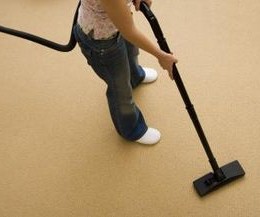vacuuming your carpet
To get the most effective carpet cleaning we require carpet vacuuming. You can elect to do this yourself or we will do it at an additional cost. Vacuumed carpet will allow the pre treatment to do the job that it is meant to do; dissolve the soil that has bonded to the carpet fibers and not be soaked up by removable debris left in the carpet.
The basics of vacuuming and important info on choosing a vacuum
General Vacuuming Carpet Care Guidelines
Vacuuming is effective in removing most of the dry soil from your carpets. However, periodic professional cleaning is highly recommended to remove the oily, sticky soil that accumulates in the pile from tracked-in dirt, air pollution and even cooking vapors. This oily soil is most evident to the eye on light or pastel carpets – they seem dull; an oily film hides the delicate color – but it’s there on every carpet. If this type of soil is allowed to build up, it actually begins to attract and hold the dry soil, eventually becoming gummy and very difficult to remove.
The most important step in caring for your carpet is vacuuming. Vacuum thoroughly and frequently, particularly in high-traffic areas. Bear in mind that walking on soiled carpet permits the soil particles to work their way below the surface of the pile where they are far more difficult to remove and can damage the fibers. Frequent vacuuming removes these particles from the surface before this happens.
Vacuuming Tips
For rooms with light traffic, vacuum the traffic lanes twice weekly and the entire area once weekly. Those areas with heavier traffic require that the traffic lanes be vacuumed daily and the entire area twice weekly. Up to three passes of the machine will suffice for light soiling, but five to seven passes are necessary for heavily soiled areas. Change the vacuuming direction occasionally to help stand the pile upright and reduce matting.
Vacuum cleaner recommendations
A good vacuum cleaner is vital to prolonging the beauty and life of your carpet. An inexpensive machine can remove surface dirt but will not effectively remove the hidden dirt and particles embedded in the pile.
Our company recommends the use of vacuums with a rotating brush or combination beater/brush bar that agitates the carpet pile and mechanically loosens soil for removal by the vacuum. Note that carpet with thick loop pile construction, particularly wool and wool-blend styles, may be sensitive to brushing or rubbing of the pile surface and may become fuzzy. For these products, we recommend the use of a suction-only vacuum or a vacuum with an adjustable brush lifted away from the carpet so it does not agitate the pile. A vacuum with a beater/brush bar can be tested in an inconspicuous location and used if no excessive fuzzing occurs.
Replaceable paper vacuum bags do a better job of trapping the small particles that pass through cloth bags back into the room. High efficiency vacuum bags, also called micro filtration bags, trap even smaller microscopic particles such as mold and mildew spores and dust mite byproducts, often found to be a source of allergies. This type of bag is sold under several brands, such as the “MICRO-LINED” bag available at most vacuum specialty shops, or the “MICRO-CLEAN” bag available at some department and discount stores, and “MICRO FILTRATION” and “MICRO LINER” brands available. These bags are available under other brand names; verify that these bags trap particles smaller than two (2) microns. All vacuum bags should be checked often and replaced when half full.
Make sure the belt is in good condition and that the brush or beater bar rotates when in contact with the carpet. To adjust the vacuum to the correct height setting for the carpet, raise the beater/brush bar to the highest setting and then lower it until it contacts the pile enough to slightly vibrate the carpet several inches away from the machine, but not low enough to cause significant slowing of the motor.
Change the vacuuming direction occasionally to help stand the pile upright and help reduce matting.
